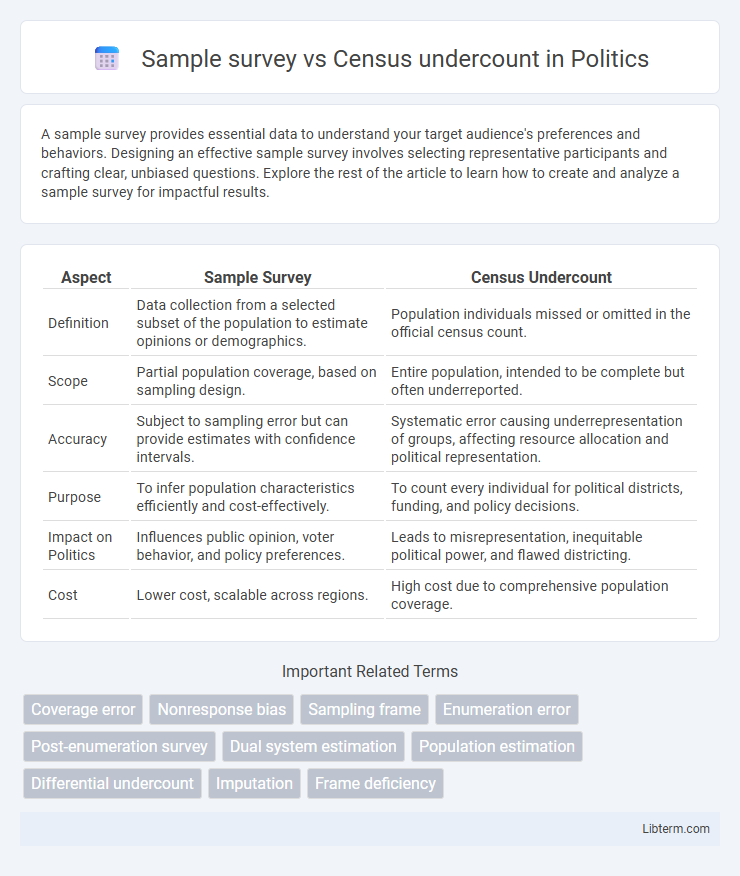A sample survey provides essential data to understand your target audience's preferences and behaviors. Designing an effective sample survey involves selecting representative participants and crafting clear, unbiased questions. Explore the rest of the article to learn how to create and analyze a sample survey for impactful results.
Table of Comparison
| Aspect | Sample Survey | Census Undercount |
|---|---|---|
| Definition | Data collection from a selected subset of the population to estimate opinions or demographics. | Population individuals missed or omitted in the official census count. |
| Scope | Partial population coverage, based on sampling design. | Entire population, intended to be complete but often underreported. |
| Accuracy | Subject to sampling error but can provide estimates with confidence intervals. | Systematic error causing underrepresentation of groups, affecting resource allocation and political representation. |
| Purpose | To infer population characteristics efficiently and cost-effectively. | To count every individual for political districts, funding, and policy decisions. |
| Impact on Politics | Influences public opinion, voter behavior, and policy preferences. | Leads to misrepresentation, inequitable political power, and flawed districting. |
| Cost | Lower cost, scalable across regions. | High cost due to comprehensive population coverage. |
Understanding Sample Surveys and Census Undercount
Sample surveys rely on a subset of the population to estimate characteristics, making them susceptible to sampling error but allowing quicker, cost-effective data collection. Census undercount occurs when certain populations, often minorities, low-income groups, and transient individuals, are systematically missed, leading to biased demographic and socio-economic data. Understanding these distinctions helps improve data accuracy by addressing the limitations of sample coverage and undercount correction methods in national surveys.
Key Differences Between Sample Surveys and Census
Sample surveys estimate population characteristics by collecting data from a subset, while censuses aim to count every individual, often leading to greater accuracy but higher costs. Undercounts in censuses occur due to missed individuals or households, causing potential bias, whereas sample surveys reduce costs but rely on statistical inference, which introduces sampling error. Sample surveys offer quicker, more flexible data collection with adjustable sample sizes, contrasting with the exhaustive and time-intensive nature of censuses.
Causes of Census Undercount
Census undercount primarily occurs due to factors such as non-response, inaccessible locations, and data processing errors, which often affect marginalized and transient populations disproportionately. Sample surveys mitigate some undercount issues by using stratified sampling and follow-up procedures to improve data accuracy. However, both methods face challenges in capturing hard-to-reach groups, leading to potential biases in population estimates.
Impact of Undercount on Data Accuracy
Undercount in census leads to significant inaccuracies by missing segments of the population, distorting demographic representation and skewing resource allocation. Sample surveys, while prone to sampling errors, often provide more timely and cost-effective estimates, but their accuracy depends on sample design and response rates. The impact of undercount in census data challenges the reliability of policy decisions, funding distribution, and demographic analysis, making adjustment methods essential for more accurate population metrics.
Sample Survey Methods to Address Undercount
Sample survey methods address census undercount by employing stratified sampling and dual-system estimation to enhance accuracy. Techniques such as capture-recapture models use independent data sources to identify missed populations, reducing bias in demographic estimates. Advanced weighting adjustments and post-stratification refine population counts, improving coverage and representation in undercounted groups.
Census Undercount: Populations Most Affected
Census undercount disproportionately affects minority populations, low-income households, and transient communities, leading to gaps in vital demographic data. African Americans, Hispanics, Native Americans, and undocumented immigrants often face barriers such as language differences, distrust of government, and housing instability, contributing to underrepresentation. Accurate census counts are critical for equitable resource allocation and political representation, making these undercounts a significant issue for social justice and policy planning.
Statistical Techniques for Adjusting Census Undercount
Statistical techniques such as dual-system estimation (DSE) and capture-recapture models are essential for adjusting census undercount by integrating sample survey data to estimate elusive populations. Post-enumeration surveys (PES) complement the census by identifying discrepancies and quantifying undercount rates across demographic groups, enhancing accuracy in population counts. These adjustments reduce bias in census data, improving resource allocation, policy development, and demographic analysis.
Consequences of Census Undercount in Policy Making
Census undercount leads to inaccurate population data, resulting in misallocated government funding and resources for social programs like education, healthcare, and infrastructure. Policy decisions based on incomplete census data can exacerbate inequalities by underrepresenting marginalized communities, thereby affecting political representation and legislative redistricting. An undercount also compromises the reliability of demographic statistics critical for long-term planning, economic development, and disaster response strategies.
Ensuring Representativeness in Sample Surveys
Sample surveys reduce undercount risks compared to censuses by employing statistically designed sampling techniques that ensure representativeness across diverse populations. Stratified sampling and weighting adjustments correct for potential biases, thereby providing accurate demographic estimates even in hard-to-reach groups. Ensuring high response rates through targeted follow-ups further minimizes underrepresentation, enhancing data reliability and policy relevance.
Improving Future Censuses: Reducing the Undercount
Improving future censuses requires targeted strategies to reduce undercount by addressing common causes such as nonresponse and misreporting. Advanced sampling methods, enhanced respondent outreach, and integration of administrative records strengthen data accuracy and coverage compared to traditional census enumeration. Employing these techniques reduces the disparity between sample survey estimates and actual population counts, ensuring more reliable demographic insights.
Sample survey Infographic

 libterm.com
libterm.com